This post contains affiliate links.
Urban Fermentation is about fermenting in your own kitchen. What can you make with limited space and a low tolerance for smelly things.
The answer is quite a lot actually. Fermenting does not have to take up a lot of space, make your house smell off or take a long time.
Kefir
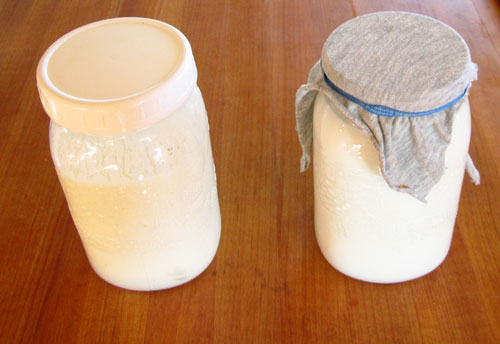
Kefir made with kefir grains is easiest when made in a jar in small batches. I like to use wide mouth mason jars. This makes them easier to clean once the kefir is gone.
Kefir is a great ferment to start with because it not only tastes great it is very versatile. It can be used in smoothies, poured on top of cereal or you can just drink it.
It contains a wide variety of probiotics in high counts which help your digestion and is also easier to digest then regular milk as the probiotics in the kefir break down the lactose. This makes kefir a good choice for anyone who is lactose intolerant.
Not only does it provide probiotics but it also provides a variety of vitamins including several B vitamins, vitamin C, and vitamin D due its addition to most milks in North America.
Once you get into the groove of making kefir it takes less than a minute to make and you will always have a fresh jar in the fridge and a new one fermenting for the next day.
Yogurt
Yogurt made with a powdered starter culture is a great way to learn if you want to make your own yogurt. It takes 8-24 hours depending on how tangy you like your yogurt and how much lactose you want left in it after fermentation.
Yogurt can also be made from fresh yogurt purchased from the store. The cultures in the store bought yogurt are strong enough to make new yogurt one or two times but after that you risk losing a batch to unfriendly bacteria giving the yogurt an off smell.
The best method is to get a package of heritage yogurt starter. These starters have a wide variety of bacterial cultures in them making them very robust and can continue to make new yogurt indefinitely. There are different types, some which ferment without added heat and some which need a higher then room temperature to ferment properly.
If you are lucky you may get a starter from someone who has a heritage yogurt which has been perpetuated for years. Some yogurt cultures have been passed down through generations.
Sauerkraut
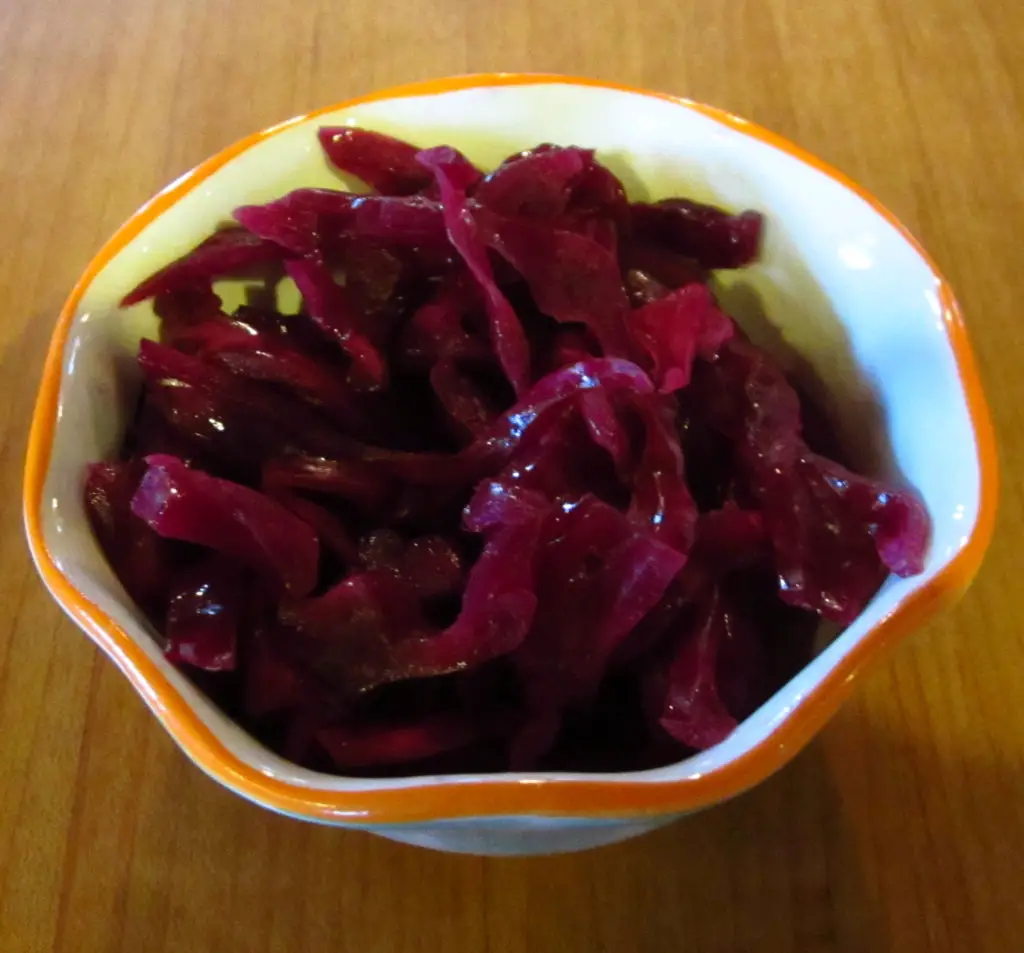
Although sauerkraut takes a little longer then kefir or yogurt it is still a great fermentation to make in a jar.
You will need a cool place to put it where you can forget about it for a while but not for too long as you will want to start tasting it as it approaches the level of tanginess you want.
Sauerkraut is basically salted cabbage fermented in an anaerobic environment. This gives lactic acid bacteria (LAB) an ideal environment for it to convert the sugars in the cabbage into energy and produce the acidic environment which protects the sauerkraut form spoilage.
For best results ferment sauerkraut in a cool location with a minimum of salt (2% salt by weight). This helps to reduce the amount of histamines in the sauerkraut which some people are sensitive to.
Pickled Carrots
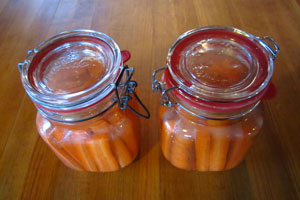
Carrots have a lot of sugar in them. If you have ever had fresh carrot juice (not the stuff from the grocer but actually freshly made carrot juice) you will know just how sweet carrot juice can be.
It is this sugar that the LAB consume to make the pickles so tangy and delicious. The carrots will ferment all by themselves if they are stuffed into a jar with a 2-3% salt brine added and left to ferment with a lid on for a week or two.
Depending on the type of jar you use you may have to let the pressure out of the jar daily to prevent any kitchen explosions.
Carrot pickles are crunchy additions to any meal. Are great with a sandwich, grated into a salad or just eaten as a healthy snack.
Kvass
This ferment can be made a number of ways. The original kvass was made from stale sourdough bread. The bread was added to water and sugar with a bit of starter then left to ferment for a short period of time. The result is a fizzy refreshing drink.
Other types of kvass are made by soaking vegetables in salted water for periods of one to two weeks. This makes a healthful drink with the vitamins and minerals in it which were in the vegetable it was made from. It also contains several vitamins which the bacteria in the kvass produce while they consume the energy in the vegetable.
One of my favorites is beet kvass for its earthy flavor and health affects it has on the liver and kidneys but carrot kvass is also good to try. If you want why not try lettuce, radish or pepper kvass. Each one will produce a unique flavor and vitamin profile.
Kimchi
Kimchi in a jar is a good way to perfect your recipe for this famous fermentation from Korea. Since there are as many recipes for kimchi as there are families in Korea, one more (yours) will add another dimension to what is kimchi.
The nice thing about the jar method is that the batches can be small so you can alter the recipe in stages without wasting anything.
Once you get a recipe you like then make a larger batch by just using a bigger jar.
Pickled beets
Red beets are full of sugar. Not as much sugar as sugar beets but they still store a lot of energy in the bulbous root.
This makes them ideal for producing pickles because the LAB need energy to produce the lactic acid which makes the pickles tangy while keeping them crunchy.
Simply cut the beets up into pieces of any shape you choose put them into a jar and add a 2% brine to cover the beet pieces. Ferment until the beets are tangy.
Fermented salsa
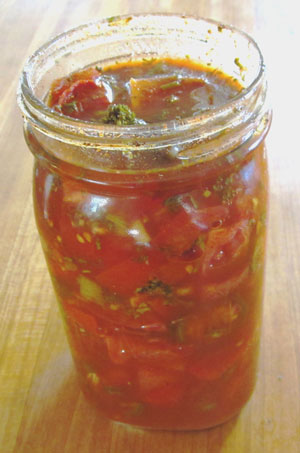
Salsa is a great thing to have around. It is a fast snack with chips, is an integral part of taco salad and has been known to garnish more than one smoky.
The store bought version is usually made with white vinegar and powdered spices. Not what anyone could consider health food.
But how about fermented salsa. It is full of probiotics, can be made as hot or mild as you wish and has great flavor. It actually makes it easier to digest the meal you have it with rather than the other way around.
To make a spicy cream dip you can add some fermented salsa to some kefir cream cheese. It goes great with chips or as a hamburger condiment.
Mango vinegar
Mangos are very sweet, especially when they are fully ripe. Eaten fresh they are wonderful additions to fruit salads, in curries or just eaten by themselves.
The hard part about mangos is getting all the flesh off the pit and skin so as to not waste any.
Mango vinegar is an easy way to use the entire mango and get a summer salad vinegar in the process.
Make sure you get ripe mangos and wash the outside thoroughly before slicing it up.
Salted preserved lemons
These preserved lemons are a great addition to your fermented food cupboard. They are best made with thin skinned lemons like Myers lemons but can also be made with thick skinned lemons. The lemons will slowly ferment producing tangy-sour lemons.
Salted preserved lemons are popular in Morocco where they are used in several dishes like tagines and meat dishes like baked lamb.
Pickled ginger
If you are a sushi fan you know the flavor of pickled ginger. It is usually added to a package of sushi as a garnish. It has a slightly hot and tangy flavor which goes nice with the sushi.
Naturally fermented pickled ginger is easy to make and has good for you bacteria which help digestion and improves the environment of the digestive system.
Once you have tried it you will start to add it to all sorts of things like salads, stir fries and curries.
You may find yourself opening the jar in the fridge and snacking on them by themselves.
Fermented ketchup
Ketchup was originally fermented. It has only been recently that condiments, including ketchup have been made with white vinegar, sugar and tomato paste.
Fermented ketchup can be made using tomato paste from the can or from fresh tomatoes made into a sauce. It needs to be acidified quickly so the use of some type of raw vinegar for best results.
The spices are up to you. Start with this recipe and experiment.
Fermented ketchup adds probiotics to anything it is added to (which is valuable when you try to digest a hotdog).
Fermented mustard
Just as ketchup can be fermented so can mustard. You can use seeds and make a grainy mustard or powder or make a smooth type out of mustard powder.
It is important to remember that as fermented mustard acidifies it gets hotter. This is because the heat in the mustard is released with the addition of acid. This means that the longer the mustard ferments the hotter it will get (up to a point). Taste it often and when it gets to the desired heat and tanginess refrigerate it to slow the fermentation down.
Kombucha
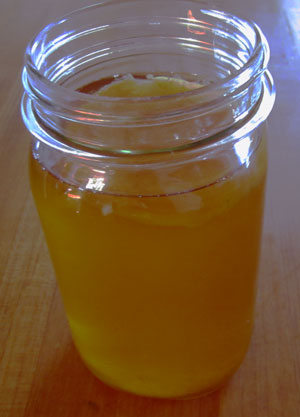
Full of probiotics, tannins and good for you lactic acid bacteria, kombucha has taken the world by storm. It has gone from a little known health drink to a mainstream grocery store item.
This is good and bad. Good because you can now buy kombucha almost anywhere, bad because not all kombuchas are the same.
Here’s a hint: If it isn’t refrigerated it does not have live culture in it. Before you buy any be sure to read the label or better yet make some of your own.
It can be made out of almost any tea, although for the most health benefits green tea or black tea are best. It can be as sweet or tangy as you want and can be sweetened with any glucose containing sweetener.
You can drink it plain as a tonic or make it into a soda by adding flavorings and sealing it in pressure safe containers.
Sourdough starter
Sourdough bread has many benefits over normal store bought bread. It is easily digested, provides vitamins and minerals which are not available in store bought bread and has a nice tangy flavor.
It also lasts longer on the shelf due to its slightly acidic nature.
But you can’t make sourdough bread without a sourdough starter.
For this you have two choices:
- Buy a starter online or from a health food store
- Make your own
To make your own all you need is a jar, water and flour and in a short time you will have more starter than you know what to do with.
Which is a great problem to have because it gives you a chance to make sourdough pancakes, banana bread and biscuits.
Of course you will be able to make sourdough bread as well.
Fermented chutney
Another condiment which has been altered to become a sickly sweet white vinegar concoction which can sit on a shelf indefinitely at a grocery store.
Not so with fermented chutney. It is full of good for you bacteria, vitamins and accessible minerals. It can help get all the food value out of the food you eat it with rather than adding to the burden on your digestion.
Ginger bug
Ginger bug is a starter for several tonics and non-alcoholic soda. It can be used to start your own root beer soda or ginger ale.
A ginger bug can be started simply by grating some ginger into a jar. Then add some sugar and a little filtered water and stir.
Every day for a week or so add a little more ginger sugar and water and stir. Once the mixture starts to bubble and fizz you will have a ginger bug.
Now use it to make ginger ale or add it to a smoothie for a probiotic kick.
Relish
The relish we know today is made with white vinegar mixed and a variety of sugars from corn syrup to palm sugar. It has no nutritional value besides calories (which most of us don’t need) and will add to the burden of digesting the hotdog or burger you are eating it with.
For a different experience try making a fermented relish. It is easy, can be made in a jar and will help your digestion of those hotdogs and burgers.
You can make it from cucumbers but don’t be limited. It can also be made with radishes, carrots or any other vegetable of your choice.
Hot pepper sauce
Hot pepper sauce has a place in anyone’s fridge. It adds zing to a meal, heat to a drink and probiotics to your digestion.
Some hot pepper sauces you get at the grocery store are still made by fermenting hot peppers, blending the result and bottling it for sale. You can do the same in your own kitchen.
The spice level is up to you. You can use mild peppers, hot peppers or stupidly hot peppers. You can mix the flavors up or just stick with one type throughout. This is the fun of fermenting in a jar as even if you get a hot pepper sauce which is inedible you can start again with a minimum of waste.
Tomato sauce
Fermented tomato sauce has to be tried to understand what it is like. It can be made with any variety of spices from Italian to Asian. It is handy to have to pour onto some pasta, add to a stir fry or used as a topping for burgers.
It is best made with fresh tomatoes and can be a great way to use up an over-abundance of tomatoes which can come out of the garden at harvest time.
Strawberry vinegar
Strawberries have a flavor which is reminiscent of summer. When you smell the fragrance of fresh strawberries it can take you back to hot days outside enjoying the sun.
For a healthy reminder of the summer season without buying strawberries grown thousands of miles away try making this vinegar from local in season strawberries.
Then in the winter you can make yourself a salad mix up a strawberry vinaigrette and remember the sun.
Pickled jalapenos
Jalapenos have great flavor and are pleasantly hot, but once you pickle them you will find another level of flavor you didn’t know existed.
Pickled jalapenos can be added to numerous dishes Mexican or not for an additional kick. I like to add them to most tomato based sauces including Italian sauces.
They make a necessary addition to taco salad both in the taco meat as well as added on top for that additional heat.
They are simple to make and keep for a long time in the fridge. Although once you have tried them they will be consumed long before they can go off.
Pickled Garlic
Garlic is another vegetable which has medicinal properties. It has been given a lot of attention from health practitioners. It has been recommended for cancer prevention, boosting your immunity and repelling vampires.
Obviously not all the recommendations are valid (who ever heard of garlic boosting your immunity) but the recommendations will not matter to you once you try fermented garlic.
The fermentation process mellows the flavor and adds a unique tangy earthy flavor.
Elderberry tonic
Another traditional health drink. Elderberry tonic is full of vitamins, minerals and probiotics which help the digestion and boost the immune system.
It can be made by adding elderberries to water and a little sugar and stirring regularly for about ten days or so.
When the mixture begins to fizz continue stirring for a few days. Then strain out the elderberries and put the resulting liquid into a pressure proof bottle. Store in the fridge and drink when you feel you are coming down with something (or when you want a tasty liquid shot).
Fermented oatmeal portage
Oatmeal portage is an old time favorite breakfast. It is full of energy, sticks with you all morning and is a great comfort food.
To add to its digestibility try soaking the oatmeal for 12 hours or so before you make it into portage. This will help break down the hard to digest anti-nutrients which the grain uses to protect itself from the environment while it waits to sprout in the spring.
Of course while the oats are soaking they are also fermenting and depending on the amount of time you soak your oatmeal will be more or less fermented.
As you can see there are lots of options for fermenting with little space, few ingredients and no equipment. All you need is a jar, a knife and your imagination so go find something to ferment.
